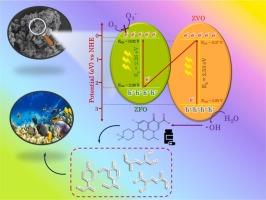用Ni和Mn共掺杂调制ZrFe2O4/Zn3(VO4)2中的电子结构以增强氧氟沙星的光催化矿化
IF 6.3
2区 材料科学
Q2 CHEMISTRY, PHYSICAL
引用次数: 0
摘要
淡水系统中抗生素污染物的增加对水生生态系统构成严重威胁,迫切需要有效的修复策略。本研究合成了Ni和Mn共掺杂的ZrFe2O4/Zn3(VO4)2异质结,用于光催化矿化氧氟沙星(OFX)。显微结构分析证实了Zn3(VO4)2在ZrFe2O4上的成功装饰,(044)衍射面的出现证实了这种整合。XPS进一步验证了元素组成及其氧化态,ESR分析证实了氧空位的存在。PL、EIS和ESR的互补结果显示,异质结体系中电荷载流子分离增强,e-/h+重组抑制,ROS生成增加。其中Zr0.8Ni0.1Mn0.1Fe2O4/Zn3(VO4)2的光催化活性最高,去除率达到96.9%,速率常数为0.0322 min-1,分别是原始ZrFe2O4和Zn3(VO4)2的1.7倍和3.25倍。这种优异的活性归因于Fe2+/Fe3+氧化还原对的协同参与,促进了光- fenton增强•OH自由基的产生。此外,BET等温线显示复合材料具有更高的比表面积,进一步提高了光催化效率。对连续6次光催化循环进行的重复利用研究表明,其重复利用效率高达98.12%。此外,XRD和XPS研究阐述了材料的光稳定性和腐蚀性能。光催化降解也在实际水基质中进行了评估,确认了实际环境应用的潜力。对TOC去除率进行了评价,以确定其光降解潜力。最后,通过GC-MS鉴定了降解中间体,并对其对藻类、水蚤和鱼类的生物毒性进行了评价,确认了该工艺的环境相容性。本文章由计算机程序翻译,如有差异,请以英文原文为准。

Modulating electronic structures in ZrFe2O4/Zn3(VO4)2 by Ni and Mn co-doping for enhanced photocatalytic mineralization of ofloxacin
Increasing presence of antibiotic pollutants in freshwater systems poses a serious threat to aquatic ecosystems, underscoring the urgent need for effective remediation strategies. In this study, Ni and Mn co-doped ZrFe2O4/Zn3(VO4)2 heterojunctions were synthesized for the photocatalytic mineralization of ofloxacin (OFX). Microstructural analysis confirmed the successful decoration of Zn3(VO4)2 atop ZrFe2O4, with the appearance of the (044) diffraction plane validating the integration. XPS further verified the elemental composition and their oxidation states, while ESR analysis confirmed the presence of oxygen vacancies. Complementary insights from PL, EIS and ESR revealed enhanced charge carrier separation, suppressed e-/h+ recombination, and increased ROS generation, respectively in the heterojunction system. Among the tested compositions, Zr0.8Ni0.1Mn0.1Fe2O4/Zn3(VO4)2 exhibited the highest photocatalytic activity, achieving 96.9% OFX removal with a rate constant of 0.0322 min-1, which is 1.7 and 3.25 times higher than that of pristine ZrFe2O4 and Zn3(VO4)2, respectively. This superior activity is attributed to the synergistic involvement of the Fe2+/Fe3+ redox couple, facilitating photo-Fenton to enhance the •OH radicals production. Additionally, BET isotherm revealed a higher specific surface area of the composite, further improving the photocatalytic efficiency. Reusability studies carried out for six consecutive photocatalysis cycles demonstrated a high reusability efficiency of 98.12%. Additionally, XRD and XPS studies elaborated the material’s photostability and corrosion. Photocatalytic degradation was also assessed in real water matrices, confirming the potential for practical environmental applications. TOC removal was also evaluated to confirm the photodegradation potential. Finally, degradation intermediates were identified via GC-MS, and their biotoxicity of the intermediates was evaluated against algae, Daphina and fish, confirming the environmental compatibility of the process.
求助全文
通过发布文献求助,成功后即可免费获取论文全文。
去求助
来源期刊

Journal of Alloys and Compounds
工程技术-材料科学:综合
CiteScore
11.10
自引率
14.50%
发文量
5146
审稿时长
67 days
期刊介绍:
The Journal of Alloys and Compounds is intended to serve as an international medium for the publication of work on solid materials comprising compounds as well as alloys. Its great strength lies in the diversity of discipline which it encompasses, drawing together results from materials science, solid-state chemistry and physics.
 求助内容:
求助内容: 应助结果提醒方式:
应助结果提醒方式:


